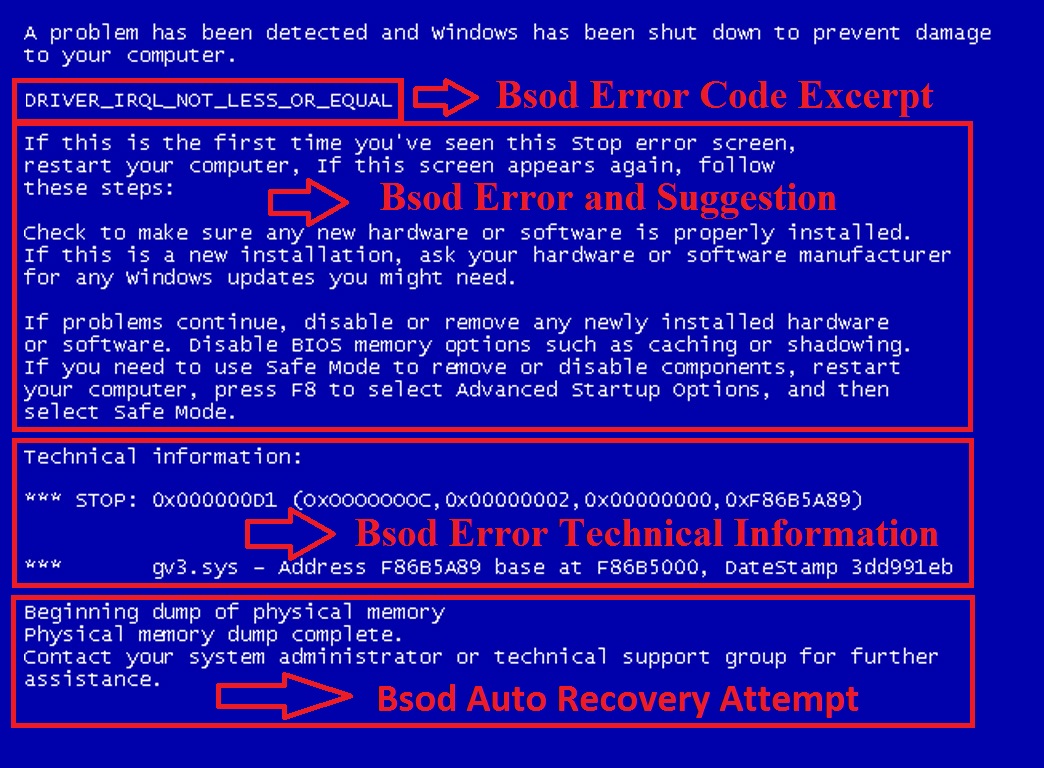|
|
2.2 Given a scenario, explain and interpret common hardware and operating system symptoms and their causes
- OS related symptoms
- Bluescreen
When Microsoft Windows encounters a condition that compromises safe system operation, the system halts. This condition is called a bug check. It is also commonly referred to as a system crash, a kernel error, a Stop error, or BSOD. A hardware device, its driver, or related software might have caused this error.

More on Blue Screen
Demystifying the Blue Screen of Death
- System lock-up
A system lock-up can be described as a very long delay in which the system becomes unresponsive and no error messages are presented.
A lock-up can be caused by either hardware or software issues. Common reasons for lock-ups can be from Windows running low on resources or available memory. In this situation, it can be helpful to close any unnecessary applications, increase the size of your pagefile, or increase the amount of memory installed in the system.
- Input/output device
Issues with input/output devices can be the result of either a hardware or software failure. The device itself may be faulty, there may be a problem with the device's connection, or a problem with the device driver or a particular application.
- Application install
Application installations don't always go as planned, and errors may happen for a number of reasons. Most applications will require all other programs to be closed before proceeding to avoid conflicts with system resources. Try restarting your computer, or uninstall the program and re-install it again to see of the problem persists. If there is a start or load failure, verify that the application is compatible with your operating system. Check the manufacturer's website for an available patch or upgrade.
- Start or load
Start or load issues can occur for a number of reasons, and you may not always recieve an error message when it happens. If you recieve an error message that refers to a particular file or service, you may be able to disable the file or service in the System Configuration Utility (Msconfig.exe) or by using Computer Management. If a program or a Windows component has been recently installed, check the Device Manager for problems with the drivers. If a program has been removed by deleting it manually, remnants of the program could remain causing issues. In some instances, starting in Safe Mode or using the Last Known Good Configuration tool may be necessary.
More on Start or Load Issues
- Windows specific printing problems
- Print spool stalled
A print spooler is software that temporarily stores print jobs on the computer hard disk or in memory until the printer is ready to print them. This buffering technique allows the processor to perform other operations while the printing is performed in the background. Documents in the print queue that will not print and cannot be deleted may be the result of a stalled print spooler. To correct this issue, try to stop and restart the Print Spooler service. If the issue persists, check the hard drive. There might not be enough space for spooling the document. If not, relocate the spool folder to another volume. Once you have cleared and restarted the Print Spooler, go back and re-print all the affected print jobs.
- Incorrect / incompatible driver
A print job that prints garbled text or is otherwise not legible could be a sign of a corrupt or incompatible printer driver. Most printers will have driver software bundled with the Windows CD, but a printer that was released at a later date may not. Under such circumstances, you may need to load the printer driver software manually. If you cannot find the proper printer driver on any of the disks that came with the printer, check the manufacturer's web site.
If a printer continues to produce gibberish printing after updating the driver, check for cable or port damage.
- Hardware related symptoms
- Excessive heat
A computer system contains a number of electronic components that produce heat. Excessive heat generated from these components can reduce their lifespan and lead to data loss and irreparable damage. A combination of heat sinks and cooling fans are typically used to dissipate heat and keep the components working within safe operating temperatures.
- Noise
Almost all PCs emit noise to a certain degree. With today's modern design, most of these noise levels are kept relatively low and pose no threat to the operator. Some power supplies will produce a slight humming sound through normal operation, and cooling fans will often produce a varying level of noise. Hard drives, floppies, and even optical will produce sounds while reading or writing data. Certain types of noise or changes in the noise emitted may indicate issues arising within the unit itself.
- Odors
Odors coming from a computer can most certainly not be a good sign. Whether it's the odor of stale cigarette smoke left behind from a previous owner, or the smell of an overheated component, an unidentified smell coming from the inside of one's computer can at the very least be an annoying experience, if not a sign of impending doom. At the first indication of an unusual odor from a PC, every effort should be made to identify the source.
- Status light indicators
Status lights provide a quick assessment of a devices status or readiness to perform. Most PCs will have a power-on indicator or hard drive activity indicator light. Printers often have lights to indicate whether or not they are online and ready, toner levels, paper issues, etc. If you're unsure of the meaning of a devices status lights, check the device manual.
- Alerts
- Visible damage (e.g. cable, plastic)
- Use documentation and resources
- User / installation manuals
- Internet / web based
- Training materials
|
|
|